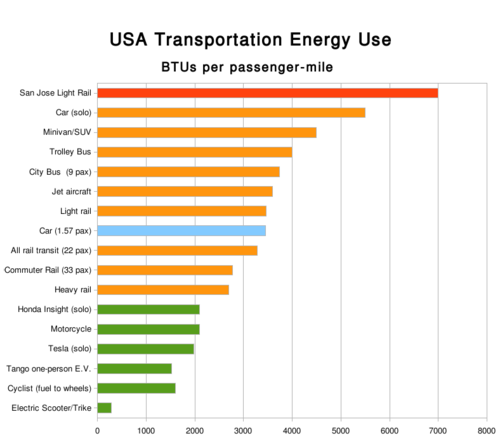Harvard prof on Houston (again) and transport energy
I'm back in town, but I have a major project due Friday, so I'll just be passing along some smaller misc items split across this post and another later in the week:- An interesting graph and discussion of energy use by different modes of transport, including various transit and personal vehicle options. You might be surprised how competitive cars can be. Hat tip to Raymond.

- Harvard urban economist Edward Glaeser had an interview in the Wall Street Journal recently with these quotes mentioning Houston (in addition to this piece in July).
"I think the relatively laissez-faire approach of Houston may be workable when you've got ungodly amounts of land you can use, but the more you squeeze in an area, the more policies you need -- and the great hope is those policies don't limit growth."Finally, I'd like to end with a random thought of the day: My sympathies to people all over the world who have to learn English as a second language, where subtleties like "tastes awful" and "awfully tasty" mean two completely different things...
...WSJ: What about looking to European cities, where more people walk and rely on mass transit, as a model for the U.S.?
MR. GLAESER: There's been a segment of urban developers who have been enthusiastic about the model in Europe for quite some time [because] it's much more environmentally sensitive. But there are bad aspects as well.
While there certainly seem to be some smart things done in Europe, it's a mistake to think they've got it right and we've got it wrong. There are many good things that came out of giving Americans the opportunity to live in big houses on the edge of urban areas.
If you think about the lifestyle of ordinary Americans living on the fringe of Houston or Dallas, for example, compared to what their lifestyle would be in an older European city -- living in a walk-up apartment there compared to a 2,500-square-foot house here they bought for $130,000 with a 24-minute commute -- it's extraordinary in the low-cost areas of this country what a $60,000 family income gets you.
There's a reason Atlanta, Dallas, Houston and Phoenix are our four fastest-growing areas. They offer an astonishingly high standard of living for ordinary Americans.
New York City is a great place to be really rich and not a terrible place to be really poor, but it's a pretty hard place to live on $60,000 a year. You don't experience anywhere near the basic standard of living you would in Houston on the same income."
Labels: environment, land-use regulation, mobility strategies, new urbanism, perspectives



4 Comments:
My sympathies to people all over the world who have to learn English as a second language, where subtleties like "tastes awful" and "awfully tasty" mean two completely different things...
Tory,
As someone who has spent nearly two years of my life in Asia and have encountered more than my fair share of language faux pas, I say to hell with learning English. You have yet to experience the joys of reading or speaking either Engrish or Chinglish!
Neal
For all the negatives you have written about Dallas and DART, seems they are in fact doing pretty well:
Downtown Dallas lures firms with transit
Excerpts:
"During the first half of 2008, downtown Dallas had more office leasing than all of the suburban areas combined. "
"Downtown's position as the hub of regional rail traffic is in big part driving the prosperity, Mr. Puckett said. "
"Never before have we had gasoline prices so high, and that's having a big impact," he said. "With the central business district being rich in DART rail and the added line going to D/FW Airport, it is a major decision factor" by companies considering a move."
I am not the least bit surprised at how competitive MULTI-PASSENGER cars can be. The problem, in Houston and elsewhere, is solo occupant cars and SUVs. The last survey I saw put sole occupant commuters in Houston at 88%, I believe.
So, what does the practical transit planner do? He encourages those modes that do well (rail, bus, carpool, vanpool, hybrid car, motorcycle), and discourages those modes that do poorly (sole occupant cars and SUVs). How does he do so? The two most obvious ways are to increase and improve mass transit options, and increase the cost of sole occupant options.
This approaches the problem from two directions. Improving mass transit speaks for itself. More convenience and destinations served increases ridership. Increased ridership increases efficiency (remember, these are averages). On the sole occupant side, higher gas prices have proven that increased cost will depress miles driven. Logically, higher gas taxes will achieve the same result, as will removing tax breaks for purchasing SUVs, adding tax breaks for purchasing high mileage cars or hybrids, and adding tolls for large vehicles, while allowing the super efficient to drive free.
I think we must use an alternative energy for example electric or solar to prevent the world from air pollution.
Post a Comment
<< Home